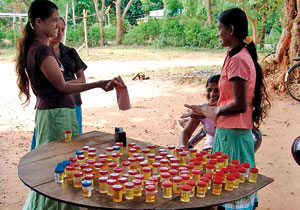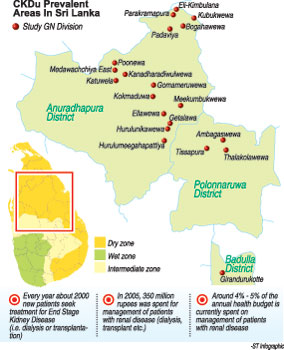Sri Lanka will come to grips with the "unknown" but burning cause of Chronic Kidney Disease felling the young male farmer of the North Central Province (NCP) and should have an answer in a few months, a top health official assured.
"We are likely to find the cause of Chronic Kidney Disease of Unknown Origin (CKDu) in about three months once all the study results are in," said Health Ministry Additional Secretary Dr. Palitha Mahipala who is also Chair of the Scientific Committee - CKDu of the National Research Project, assuring that soon there will be hope for the farmer.
The humble, beleaguered rice farmer of Anuradhapura, Polonnaruwa and adjacent areas has been grappling with suffering, dialysis and death and accepting it with stoic resignation as his 'karma', the Sunday Times understands.
Dr. Mahipala's assurance came as numerous scientists presented varied findings and debated and argued on the intricacies of research carried out and also ongoing, at a symposium organised by the Sri Lanka Medical Association last Sunday which was World Kidney Day.
Every year about 2,000 new patients seek treatment for End-Stage Kidney Disease in these areas, it is learnt.
Weaving the threads of the wide and varied research together, the National Research Project supported by the World Health Organization (WHO) and launched in late 2009 is "multi-sectoral and multidisciplinary", explained Dr. Mahipala.
 |
| Urine samples being collected for reserach and (inset left) research
assistants being trained on data collection |
With the main aim being to make prevention an option through a national public health response, according to him, the need is to zero in on the cause. The common causes of CKD, such as diabetes and hypertension, are similar to those in most parts of the world.
But what is causing CKDu in the NCP? Researchers have pointed accusing fingers at different times at fluoride, aluminium, cadmium, heavy water, well water and in more recent times arsenic while the Sunday Times as far back as December 8, 2002, raised concerns whether it was linked to pesticides, in an article headlined, 'Deadly drink?'
Explaining the need for a national research effort, Dr. Mahipala points out that though earlier a considerable body of work had been done, no systematic surveys were conducted to get the best estimates of prevalence. Through the national effort the prevalence has been estimated, he said.
Earlier there were also issues with the case definition of CKDu, he said. It was unclear from published data whether research samples were representative of the population, along with questions of a selection or response bias. There was lack of appropriate validation for most of the data available, particularly laboratory data, he stressed, pointing out that it was difficult to take policy decisions based on such data.
The urgent need was epidemiological data based on scientific studies, and the key research questions: What is the incidence/prevalence of CKDu; What is the exact geographical distribution; What is/are the definite causes; and which strategies could prevent the condition?
That's why, points out Dr. Mahipala, the national collaborative research effort has drawn together a diverse group from the Health Ministry, the provincial and regional health authorities; universities and research institutes, clinicians, nephrologists and pathologists,public health and community physicians, the National Science Foundation, the National Water Supply and Drainage Board and the Office of the Registrar of Pesticides. "Now all that has been sorted out," he said.
The National Research Project is built around:
- A population-prevalence study - all CKDu cases in the study areas have been geographically mapped through GPS and the results are available.
- A hospital-based CKD registry - with information on basic socio-demographics, lifestyle factors, environmental factors, clinical history, anthropometry and laboratory investigations for 1997 patients registered in a selected hospital. This is an ongoing activity.
- An environmental study of high and low prevalence areas - to estimate the potential toxicants in a wide-range of samples.
- A post-mortem study of cases and controls - specimens including kidney, liver and bone have been analysed for metals at the International Reference Laboratory (IRL) of the University of Antwerp, Belgium, and while some results are out, others are awaited.
Meanwhile, Peradeniya University researchers will also analyse kidney and bone specimens for aluminium, lead, cadmium, arsenic and fluoride.
- A case control study to analyse urine for metals -- some results from IRL after analysis for cadmium, lead and arsenic are available while others are awaited.
- A case control study to analyse nails and hair for arsenic - results awaited from IRL.
- A study of nephrotoxic herbal remedies - results available
- A socio-economic and productivity impact study - community-based survey completed but hospital-based survey still on.
- A randomized clinical trial to check efficacy of a medication - 266 CKDu patients currently part of the trial in Anuradhapura and Polonnaruwa.
Focusing on the three-prong environmental study, Dr. Mahipala said it included two analyses at the Kelaniya University and IRL along with a study on agrochemicals.
The analysis results from the Kelaniya University of cadmium, lead and iron levels in samples of drinking and irrigation water, rice, pulses, freshwater fish, lotus, foliar vegetables, breast milk as well as cow and buffalo milk are available, it is learnt.
Similarly, the results of the analysis for cadmium, lead and arsenic in drinking water samples done at the IRL are available while most of the results of a metal analysis of reservoir sediments, water from different sources, soil of agricultural and non agricultural land, rice, locally-grown pulses and vegetables, freshwater fish and fertilizer/pesticides are also available, he said.
Part of the environmental study on agrochemicals such as making a comprehensive list of pesticides used in the CKDu-prevalent areas and a control area of Hambantota is complete.
However, soil samples from paddy fields, vegetable plots and chena cultivations and fertilizer and pesticide samples collected from those areas are still being analysed for metals such as arsenic, cadmium, selenium and lead, the Sunday Times understands.
Stressing that the need is to think of the NCP farmer who has to be saved from CKDu, Dr. Mahipala pointed out that piecemeal release of study findings should be avoided.
Don't work in isolation, he advised researchers, adding that the goal should be to put the diseased and dying farmer before oneself.
Concrete decision after all results are in
When asked what the likely cause of CKDu may be, Dr. Mahipala declinedto comment, requesting that all results be awaited to take a concrete decision and promptly implement preventive measures.
He urged those conducting research independently to give their inputs to the national effort by contacting him at ddgphs@gmail.com
A project has also been launched to collect and collate both published and unpublished information, planned research etc., into one document for reference for further research. Researchers may send information to the CKDu Literature Repository under Prof. Rezvi Sheriff and Dr. N. Janakan on e-mails: ckdu.litrep@gmail.com or rezvi.sheriff@gmail.com
According to Dr. Mahipala seeing the disease burden and suffering (see graphic), the Health Ministry is in the process of setting up a fully-fledged dialysis unit at Polonnaruwa, similar to the one at Anuradhapura. Satellite clinics are functioning in the affected areas including Padaviya, Medawachchiya, Nikawewa, Mahiyanganaya and Girandurukotte, he said.
Laboratory facilities have also been strengthened in major hospitals in the NCP, while in Colombo , the National Dialysis and Transplant Unit is functioning at Maligawatte, he added. |



